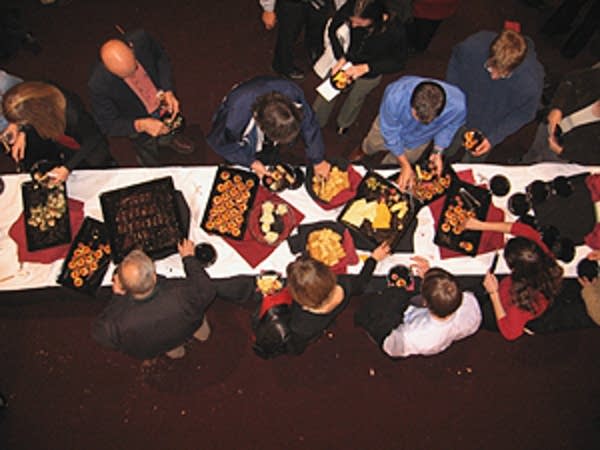Body donors remembered with poetry, music and gratitude
Go Deeper.
Create an account or log in to save stories.
Like this?
Thanks for liking this story! We have added it to a list of your favorite stories.

The chocolate mousse cups are arranged symmetrically on the serving tray. The champagne flutes are just waiting to be filled with sparkling cider. And the choir is doing one last run through.
On this November evening, students from the University of Minnesota are recognizing a group of important donors.

These honorees didn't provide funding for a new residence hall. And they didn't pony up artificial turf for the athletic field. Their donations were much more exclusive.
"We are honoring the donors for our anatomy classes," said Elizabeth Peterson, a medical student and co-chair of this year's anatomy memorial service.
Turn Up Your Support
MPR News helps you turn down the noise and build shared understanding. Turn up your support for this public resource and keep trusted journalism accessible to all.
The annual event pays tribute to those who donated themselves to the university. These are people who requested that, upon death, their bodies be used as teaching tools for medical and dental students, future morticians and physical therapists in training.
This night is for the donors, as the students call them -- or cadavers, as they're referred to by just about everyone else.
To be clear, the honorees are not actually in attendance. They've already spent time in anatomy lab.
Still, the students want to publicly thank the people they call their "teachers and first patients." And some conventional speech about the importance of body donation just won't do.

"I'm performing in a band, and we're playing two songs," said Jameel Winter. "We're playing 'Wish You Were Here' by Pink Floyd and 'Thank You' by Led Zeppelin."
Mel Ny is dancing to 'Fields of Gold,' arranged Eva Cassidy.
And Andrea Noel is making balloon sculptures.
"I've been doing balloon art for the last 12 years," said Noel. "And I figured this would be the best way I could contribute to the memorial service."
Inflated rubber may not be the typical way to memorialize the dead. But, let's be honest. The etiquette books don't exactly offer guidelines on how to thank someone for letting you lift up their skin and examine their internal organs.
Donors give entering medical students their first real look at human anatomy. Christine Gustafson can't imagine trying to figure out how the body works without them.

"We have textbooks and we have notes and lectures, but it doesn't compare to the donation these people made," said Gustafson. "Because you can't learn anatomy without actually seeing it. It's impossible. The pictures in the books aren't the same, and it's really important to see it and feel it and be able to recognize it in a human body."
Each body donor arrives in anatomy lab with a number and a brief medical history. And that's about it.
But that doesn't mean students don't get to know their donors. Maybe it's the hot pink nail polish adorning the wrinkled hands of the 90-year-old woman. Or perhaps it's the way the muscles in the 71-year-old man's right arm scream "champion tennis player." The human side always has a way of poking through.
In fact, many students find themselves imagining what kind of life this body might have lived before it ended up on a metal table in their anatomy class.
"You need to kind of put together a story for this person," said Elizabeth Petersen. "Because they are an actual person. They're more than just an object to us."
"I sort of put together a story for my body," offered Kevin Rank. "You know, just like a really nice old man. Maybe a car salesman. I'm not sure."

"We often quoted movies," added Petersen. "We were like, 'Oh, we could she her watching this movie.'"
"My guy kind of looked like a fisherman," said Randy Foss. "Yeah. He worked on the Atlantic Ocean in my mind, I guess."
"You do have a relationship with them," admitted Sandy Parran. "Maybe that sounds odd, but you do."
After spending weeks with their donors, many students find it hard to say goodbye when the course is over. That's where the memorial service comes in.
Some students expressed their gratitude through poetry. Others offered songs by the Dave Matthews Band.
Many American medical schools hold ceremonies for bequeathed bodies. But the University of Minnesota's is one of just a few to invite the deceased's friends and family to attend.
"Somebody had the idea that this doesn't need to be a private service," said Angela McArthur, assistant director of the anatomy bequest program. "The one group that also needs some resolution and needs to decompress from the death of these donors are the family members. So why not connect these groups?"

Here, in the university's Ted Mann Concert Hall, the academic and the personal come together.
Anatomy students recognize the donor with the callused hands and the hip replacement, the guy who taught them how complex the digestive system is.
Family members honor the 95-year-old grandmother who loved Blue Bunny ice cream and is credited in history books for discovering three new species of mushrooms.
"I thought it would be more of a staid memorial service with lots of speeches. And I really liked the heartfelt creativity of the students," said Tom Weaver, whose mother donated her body to the U of M. "My mom would have really appreciated that. She's probably looking down and enjoying the whole thing."
"My husband really wanted to give himself as his last gift," said Anna Marie Korpi. "It is nice to see how useful the gift is. I am deeply moved."
Even by the Pink Floyd.






